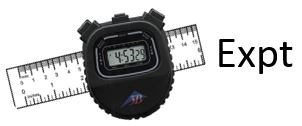PHY385 Module 6: Polarization
Table of contents
Equipment Needed for Activities 6.1 and 6.2
Optical Bench Light Source
Polarizers (2) Components Holders (3)
Ray Table and Base Ray Table Component Holder
Cylindrical Lens Viewing Screen
Slit Plate Slit Mask
 Activity 6.1 – Linear Polarizers
Activity 6.1 – Linear Polarizers
Figure 1.
Set up the equipment as shown in Figure 1. Turn the Light Source on and view the Viewing Screen with the Polarizer removed. Replace the Polarizer on the Component Holder. Rotate the Polarizer while viewing the target. Note that the Polarizer is oriented so that its polarization axis is parallel to the line between 0° and 180°. [These polarizers from PASCO are absorptive filters, also called “Polaroid”. According to http://en.wikipedia.org/wiki/Polarizer , Polaroid of this kind…
“…is made from polyvinyl alcohol (PVA) plastic with an iodine doping. Stretching of the sheet during manufacture ensures that the PVA chains are aligned in one particular direction. Electrons from the iodine dopant are able to travel along the chains, ensuring that light polarized parallel to the chains is absorbed by the sheet; light polarized perpendicularly to the chains is transmitted.”
- Does the viewing screen seem as bright when looking through the Polarizer as when looking directly at the target? Explain your observation and why you observe what you do.
- Is the light from the Light Source linear polarized? How can you tell?
Figure 2.
Now set up the equipment as shown in Figure 2. Note that both polarizers in the box are identical. Align Polarizer A so it transmits only vertically polarized light. Replace Polarizer B on the other Component
Holder. Looking through both polarizers, rotate Polarizer B.
- For what angles of Polarizer B is a minimum of light transmitted?
- For what angles is a maximum of light transmitted?When you achieve this maximum, does the target seem as bright when looking through both polarizers as when you remove Polarizer B and look through Polarizer A only?
 Activity 6.2 – Linear Polarization by Reflection: Brewster’s Angle
Activity 6.2 – Linear Polarization by Reflection: Brewster’s Angle
Figure 3.
Set up the equipment as shown in Figure 3. Adjust the Slit Plate, Slit Mask and Ray Table and Base so that a single ray of light passes through the center of the Ray Table. Notice the rays that are produced as the incident ray is reflected and refracted at the flat surface of the Cylindrical Lens. (The room must be reasonably dark to see the reflected ray.)
- Rotate the Ray Table until the angle between the reflected and refracted rays is 90°. At what angle of incidence θi does this occur?Compare with an equation for Brewster’s angle from your Hecht text, and estimate the index of refraction of the glass, if you can.
Arrange the Ray Table Component Holder so it is in line with the reflected ray. Look through the Polarizer at the filament of the light source (as seen reflected from the Cylindrical Lens), and rotate the Polarizer slowly through all angles.
- Is the reflected light linear polarized?If so, at what angle from the vertical is the plane of polarization?
Observe the reflected image for other angles of reflection.
- Is the light linear polarized when the reflected ray is not at an angle of 90° with respect to the refracted ray?
 Activity 6.3 – Some Polarization Definitions
Activity 6.3 – Some Polarization Definitions
- Briefly define the following terms:
Linearly Polarized Light
Unpolarized Light
Dichroism
Birefringence
- Do the polarizers used in activities 6.1 and 6.2 use dichroism or birefringence in order to work?
 Activity 6.4 – Malus’s Law - Theory
Activity 6.4 – Malus’s Law - Theory
- Unpolarized light is transmitted through a linear polarizer, whose polarization axis is vertical.The initial irradiance before passing through the polarizer is 1 W/m2.What is the irradiance exiting the linear polarizer?
- Linearly polarized light with polarization vector vertical passes through a linear polarizer with an angle of 30° relative to the vertical. The initial irradiance before passing through the polarizer is 0.5 W/m2.What is the irradiance exiting the linear polarizer?
- Linearly polarized light with polarization vector 30° relative to the vertical passes through a linear polarizer with an angle of 60° relative to the vertical. The initial irradiance before passing through the polarizer is 0.375 W/m2. What is the irradiance exiting the linear polarizer?
 Activity 6.5 – States of polarisations and their mathematical description (Jones vectors and matrices)
Activity 6.5 – States of polarisations and their mathematical description (Jones vectors and matrices)
- Two light waves \(E_x = E_0 \cos{(kz-\omega t)}\) and \(E_y = - E_0 \cos{(kz-\omega t)}\)overlap in space. Show that the resultant is linear light and determine its amplitude and tilt angle \(\theta\).
- Describe completely the state of polarisation of the following waves
- \(\vec{E}= \hat{i}E_0 \cos{(kz-\omega t)} - \hat{j} E_0 \cos{(kz-\omega t)}\)
- \(\vec{E}= \hat{i}E_0 \sin{[2\pi(z/\lambda-\nu t)]} - \hat{j} E_0 \sin{[2\pi(z/\lambda-\nu t)]}\)
- \(\vec{E}= \hat{i}E_0 \cos{(kz-\omega t)} - \hat{j} E_0 \sin{(kz-\omega t-\pi/4)}\)
- \(\vec{E}=\hat{i}E_0\cos{(\omega t - kz)}+\hat{j}E_0\cos{(\omega t -kz + \pi/2)}\)
- Suppose you were given a linear polariser and a quarter-wave plate. How could you determine which was which, assuming you also had a source of natural light?
- An optical filter can be described by a Jones matrix\(\begin{bmatrix} \cos\alpha & \sin\alpha\\ -\sin\alpha & \cos\alpha \end{bmatrix}\). Obtain the form of the emerging light for each of the following incident beams:
- A plane polarised beam polarised at angle \(\theta\) to the horizontal
- A left-circularly polarised beam
- A right-circularly polarised beam
- From the above, identify the filter and explain how it could be constructed.
This activity is extracted from Optics by Eugene Hecht, ed 5. Added by Damya Souami

